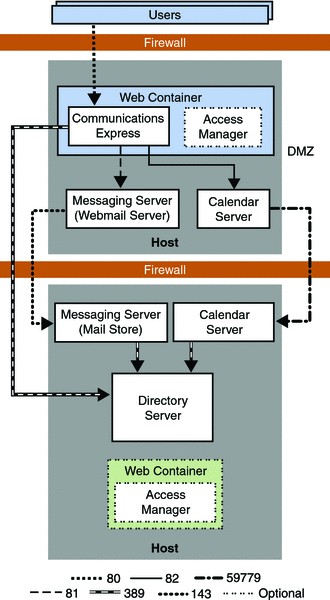Communications Express on Remote Host Architecture
Figure 24–2 shows a Communications Express architecture where both intranet and Internet users log on to Communications Express on the front-end host, which accesses the back-end host on the user's behalf. You can enable SSO on the front-end host such that Communications Express validates the session in Access Manager.
You install the front-end host with the following components:
-
Messaging Server (Webmail Server)
-
Web container
-
(Optional) Access Manager SDK
-
Communications Express
You install the back-end with the following components:
-
Directory Server
-
Messaging Server (Mail Store)
-
Calendar Server
-
(Optional) Web Container and Access Manager
Figure 24–2 shows the Communications Express on remote host architecture.
Figure 24–2 Communications Express on Remote Host Architecture

The following table explains the protocols and port numbers used by this architecture.
Table 24–2 Protocols And Ports Used by Communications Express Remote Host Deployment Example|
Protocol |
Port |
Used By |
|---|---|---|
|
HTTP |
80 |
Users to communicate with Communications Express on the front-end host in the DMZ |
|
HTTP |
81 |
Communications Express on the front-end host in the DMZ to communicate with Webmail Server also on the front-end host |
|
HTTP |
82 |
Communications Express on the front-end host in the DMZ to communicate with Calendar Server also on the front-end host |
|
IMAP |
143 |
Webmail Server on the front-end host in the DMZ to communicate with Messaging Server on the back-end host |
|
LDAP |
389 |
Messaging Server, Calendar Server, and Communications Express to communicate with LDAP directory |
|
WCAP |
59779 |
Calendar Server on the front-end host in the DMZ to communicate with Calendar Server on the back-end host |
- © 2010, Oracle Corporation and/or its affiliates
